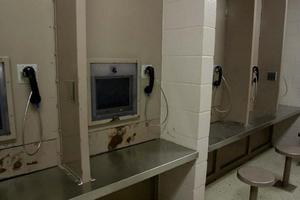For background on the U.S. Immigration and Customs Enforcement detention inspection system, read the full October 2015 report by the National Immigrant Justice Center and Detention Watch Network: Lives in Peril: How Ineffective Inspections Make ICE Complicit in Detention Center Abuse.
Facility Profile
|
Detention Standards (as of 2012): |
2000 NDS (National Detention Standards) |
|
Facility Type: |
IGSA (Intergovernmental Service Agreements) |
|
2012 ICE Average Daily Population: |
333 |
|
2011 ERO |
2012 ERO |
2012 ODO |
|||
|
Private Contract Inspector: |
MGT |
Private Contract Inspector: |
Nakamoto |
Private Contract Inspector: |
Creative Corrections |
|
Rating: |
Acceptable |
Rating: |
Acceptable |
Rating: |
N/A |
|
Deficient Standards: |
0 |
Deficient |
0 |
Deficient |
0 |
|
Deficient Components: |
9 |
Deficient |
0 |
Deficient |
8 |
In 2010, ICE planned to close the Etowah County Detention Center (ECDC) in Gadsden, Alabama, because of the facility’s poor conditions and because its remote location made it difficult for detained immigrants to obtain legal counsel or stay connected with their families and communities.1 However, arguing that the facility was an important part of the local economy, Representative Robert Aderholt (R-AL), Senator Richard Shelby (R-AL), and other members of Congress pressured ICE into keeping the facility open by threatening DHS’s budget.
Despite previous censure of the facility, oversight and accountability did not improve, leading to five separate hunger strikes within the facility in the year preceding the 2012 ERO inspection. The breadth of discrepancies from sequential years, different inspectors, and different oversight agencies are an ongoing problem in the ECDC inspections. In 2011 and 2012, ERO’s inspectors (MGT and Nakamoto, respectively) rated the facility as “acceptable” (two levels below the “superior” rating) even though the 2012 inspection identified zero deficiencies. In fact, as explained below, a 2011 deficiency was remedied in 2012 through re-interpretation of the standards, meaning that the problem was not actually addressed, but that the standards were lowered to cure the problem.
Beyond inconsistencies between ERO inspections, the 2012 ODO inspection identified eight deficiencies within five standards. Some of the ODO’s major concerns included a lack of policies concerning an emergency grievance procedure which “involves an immediate threat to detainee safety or welfare” and the procedure for requesting ICE-certified copies of identity documents (e.g., passports, birth certificates) that are essential to legal cases. Both the 2011 and 2012 ERO inspections identify these standards as having been met.
Recreation
ECDC’s indoor recreation room was counted by inspectors as offering outdoor recreation, because a window with bars qualified as providing access to sunlight and free-flowing air. The 2012 ERO inspectors wrote, “[t]his component was rated deficient during the last inspection because the facility did not offer outdoor recreation. During this inspection, the designated outdoor recreation facilities were found to be enclosed areas with secure openings that allow natural lighting and air circulation.”2 The inspectors explicitly concluded that “outdoor recreation is provided at this facility.”3 DWN’s E&C report describes the recreation area as “a cement room…the size of half a basketball court. Near the top of one or two of the walls, very high up, are relatively small windows with bars that allow outside air to enter the area. It is impossible to see anything out of these windows. People refer to it as ‘the sweatbox.’”4 The fact that indoor spaces are routinely counted as providing outdoor recreation demonstrates that the interpretation of the standards are a sham and again points to a checklist culture focused on technicalities that permit facilities to maintain their contracts, rather than upholding the intent of the standards.
Legal Orientation Programs
All three inspections also found the standard regarding legal orientation programs was met despite the fact that a legal orientation program had not been offered at the facility at any time during the past 12 months. Because individuals in ICE custody do not have the right to appointed counsel, basic legal orientation programs are the only chance many have to understand what is happening to them and how they might represent themselves in court. Amazingly, this standard is considered to have been met as long as the facility has an appropriate written policy. The 2000 NDS checklist states that if “No group presentations were conducted within the past 12 months. Mark standard as acceptable overall.”5 In comments, the 2011 ERO inspector writes, “Although there have been no group legal rights presentations in the past 12 months or any requests to do so received, the facility does have a comprehensive written policy to address group presentations if any requests are received.”6
Visitation and Programming
 |
Photo credit: Hannah Rappleye |
In DWN’s E&C report, detained individuals also reported difficulties in accessing phones (citing restrictive hours) and problems with the visitation policies. Although all of the relevant standards were rated as acceptable in the available inspections, it is striking that contact visitations are not permitted despite the distance of the facility from the nearest major metropolitan area (2.5 hour drive from Atlanta). The video visits (which still require in-person visits to the facility) are limited to 30 minutes, require prior ICE approval, and offer no privacy.
ECDC claims to offer a wide range of programs for detained people. These programs include the “World Aquaculture Program,” “Puppies without Borders,” and “Adventure Programming.” Individuals interviewed for DWN’s E&C report who were detained at Etowah said these programs were effectively nonexistent and in reality the facility had nothing more than a broken fish tank and a rock-climbing wall in a room the size of a cell.7
The inconsistent inspection findings and ignorance of detained individuals’ publicly documented concerns underpin the necessity for increased independent oversight and meaningful responses when deficiencies are found. It is not enough to reinterpret standards by lowering the bar and allowing for subpar conditions to continue.
Endnotes
1. Detention Watch Network, Expose & Close: Etowah County Jail, Alabama, Nov. 2012, at 1.
2. 2012 Etowah ERO Inspection, at 35.
3. Id.
4. Expose & Close: Etowah County Jail, Alabama, at 5.
5. 2011 Etowah ERO Inspection, at 22.
6. 2011 Etowah ERO Inspection, at 22.


